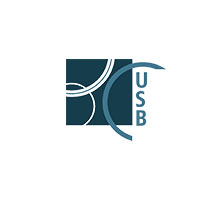Schell, Michael (2014). The role of the Caenorhabditis elegans E4 enzyme UFD-2 in DNA damage repair and apoptosis. Thesis Abstract, Universität zu Köln.
Preview |
PDF
Zusammenfassung+Abstract_Thesis2014_MSchell.pdf - Accepted Version Download (36kB) |
Abstract
DNA double-strand breaks (DSBs) are major threats for the genome of a cell and if left unrepaired they may lead to severe genomic instability which can result in apoptosis. In order to cope with DSBs a tight spatiotemporal regulation of DNA repair factors is required. These factors are recruited to lesions where they form nuclear foci to repair the damage. Timely repair is mandatory, as persisting unprocessed DSBs in pachytene nuclei of the Caenorhabditis elegans (C. elegans) germline trigger apoptosis. Yet unknown signals seem to be transmitted between the DNA damage response (DDR) and apoptosis. To allow quick responding, signaling is likely mediated by post-translational modification (PTM) of proteins located at these foci. Ubiquitylation is emerging as an important PTM in the DDR, regulating the proteasomemediated degradation of DDR-players or their displacement from chromatin. Thus, E3 ubiquitin ligases have been identified to be prominent factors in the damage response. This study demonstrates that the C. elegans E4 ligase UFD-2, a specialized form of an E3 ligase, with its binding partner the ubiquitin-selective segregase CDC-48/p97 accumulates rad-51 dependent in ionizing radiation induced nuclear foci (IRIF) in the apoptosis prone pachytene zone of the germline. The recruitment of UFD-2 and CDC-48 is independently from each other. However, impaired binding between both proteins results in misregulated UFD-2 foci, possibly caused by disturbed segregase function of CDC-48. Moreover, experiments measuring the embryonic sensitivity to IR confirm a role of UFD-2 in homologous recombination mediated DNA repair. These findings suggest that the E4 ligase UFD-2 regulates the abundance of substrates at IRIF which might serve as mediators between the DDR and apoptosis. Consistently, ufd-2 positively regulates IR-induced apoptosis and a deletion of ufd-2 results in inefficient apoptosis, correlating with persisting RAD-51 foci indicating persisting unprocessed DSBs. This study establishes a new function of UFD-2 in the displacement of an anti-apoptotic signal at sites of homologous recombination that needs to be removed for proceeding of apoptosis. It prevents undesired cell death when the damage repair is still in progress but unleashes the power of apoptosis if the DNA repair fails.
| Item Type: | Thesis Abstract |
| Translated abstract: | Abstract Language Doppelstrangbrüche (DSB) in der DNA sind bedrohlich für das zelluläre Genom und
können dieses instabilisieren was Apoptose zur Folge haben kann. Zur Beseitigung von DSB ist
eine enge raumzeitliche Regulierung der DNA-Reparatur Faktoren erforderlich. Um einen DSB
in der DNA zu reparieren werden diese Faktoren an die Bruchstelle heran rekrutiert, was als
nukleäre Foci sichtbar gemacht werden kann. Keimbahn Apoptose kann ausgelöst werden, wenn
Pachytän Kerne von Caenorhabditis elegans (C. elegans) persistierende unverarbeitete DSB
aufweisen. Aus diesem Grund ist eine rechtzeitige Reparatur der DNA erforderlich. Zwischen
den Signalwegen der DNA-Reparatur und Apoptose scheinen noch nicht bekannt Signale
übertragen zu werden. Um eine schnelle zelluläre Reaktion zu gewährleisten, werden diese Signale
vermutlich durch Post-transkriptionelle Modifikationen (PTM) an Proteinen codiert, welche sich an den nukleären Foci befinden. Im Zusammenhang mit DNA-Reparatur Mechanismen ist
Ubiquitinierung eine wichtige Form der PTM. Ubiquitinierung von DNA-Reparatur Faktoren
kann beispielsweise zu deren proteasomalem Abbau führen. Ebenso können Proteine ubiquitiniert
werden um aus Chromatin-assoziierten Proteinkomplexen herausgelöst zu werden. Demzufolge
sind E3 Ubiquitin Ligasen wichtige Faktoren der DNA-Reparatur. Diese Arbeit befasst sich mit
der C. elegans E4 Ligase UFD-2, eine spezialisierte Form von E3 Ligase, und mit ihrem
Bindepartner, der Ubiquitin-selektiven Segregase CDC-48/p97. UFD-2 akkumuliert rad-51
abhängig in nukleären Foci, welche durch ionisierender Strahlung induziert werden. UFD-2 Foci
bilden sich in der Pachytän Zone der Keimbahn, korrelierend mit dem Ort der Apoptose. Die
Rekrutierung von UFD-2 und CDC-48 an die Foci erfolgt unabhängig voneinander. Eine
ineffiziente Bindung zwischen beiden Proteinen resultiert allerdings in misregulierten UFD-2
Foci, was vermutlich zurück zu führen ist auf eine gestörte Segregase Funktion durch CDC-48.
Darüber hinaus bestätigen Experimente zur Messung der embryonalen Empfindlichkeit
gegenüber ionisierender Strahlung eine Funktion von UFD-2 im DNA-Reparaturmechanismus
der homologen Rekombination. Diese Befunde legen nahe, dass die E4 Ligase UFD-2 die
Abundanz von Substraten reguliert, welche sich an den nukleären Foci befinden. Diese Substrate
können als Vermittler zwischen der DNA-Reparatur und der Apoptose dienen. Entsprechend
positiv reguliert ufd-2 Strahlungs-induzierte Apoptose. Demgegenüber ist weniger Apoptose in
einer ufd-2 Deletionsmutante zu beobachten, was einhergeht mit persistierenden RAD-51 Foci,
welche unprozessierte DSB anzeigen. Die vorliegende Arbeit diskutiert eine neue Rolle von
UFD-2 als wichtigen Faktor in der DNA Reparatur und der Steuerung der Apoptose. UFD-2
scheint ein Anti-apoptotisches Signal zu regulieren, welches sich an der DNA befindet, die durch
homologe Rekombination repariert wird. Dieses Signal verhindert das Ablaufen von verfrühter
Apoptose, wenn die DNA Reparatur noch nicht abgeschlossen ist, leitet Apoptose jedoch ein,
wenn die Reparatur der DNA scheitert. German |
| Creators: | Creators Email ORCID ORCID Put Code Schell, Michael micha.schell@gmx.de UNSPECIFIED UNSPECIFIED |
| URN: | urn:nbn:de:hbz:38-55646 |
| Date: | 2014 |
| Language: | English |
| Faculty: | Faculty of Mathematics and Natural Sciences |
| Divisions: | Faculty of Mathematics and Natural Sciences > Department of Biology > Institute for Genetics |
| Subjects: | Natural sciences and mathematics Life sciences |
| Uncontrolled Keywords: | Keywords Language Ubiquitin, E4 ligase, UFD-2, CDC-48, apoptosis, DNA damage repair, UNSPECIFIED |
| Date of oral exam: | 20 January 2014 |
| Referee: | Name Academic Title Hoppe, Thorsten Prof.Dr. Schumacher, Bjoern Prof.Dr. Kloppenburg, Peter Prof.Dr. |
| Refereed: | Yes |
| URI: | http://kups.ub.uni-koeln.de/id/eprint/5564 |
Downloads
Downloads per month over past year
Export
Actions (login required)
 |
View Item |
